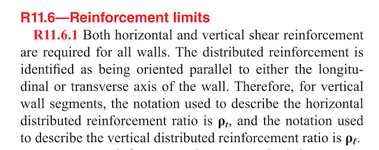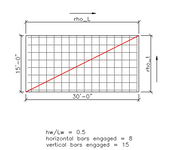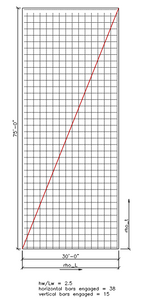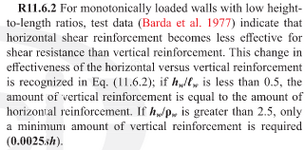LearningAlways
Structural
- Aug 17, 2014
- 69
Question about rho_L and rho_t, which is the transverse and longitudinal reinforcement ratios in shear walls.

We are talking about horizontal distributed reinforcement versus longitudinal.
There is some discussion about which bars are which in regards to these ratios, especially since precast walls are a different animal. Some folks argue that longitudinal is in the longitudinal axis of the individual precast member, while others (myself included) argue that it is the longitudinal axis of the precast stack of panels (e.g. the 75' panel stack).
This is somewhat pointed out in the code.

hw/lw points to the type of failures between 'squat walls' and typical shear walls (flexural walls?).
In the equations, as hw/lw increases and approaches 2.5 we approach 0.0025 as the minimum longitudinal. As that ratio gets smaller it become a 'squat wall'.
The commentary says that horizontal reinforcement is less effective than vertical in squat walls.
In my mind, its because the 45 degree shear plane in a squat wall is oriented more horizontally and you'll get more benefit from vertical than horizontal.


Really, a simple diagram in the code book would clear this all up. (Any code book writers out there?)
Anyway, I feel like I've seen a diagram on this site describing the different failure mechanism between squat walls and the others.
But in any case, can someone clear this up?

We are talking about horizontal distributed reinforcement versus longitudinal.
There is some discussion about which bars are which in regards to these ratios, especially since precast walls are a different animal. Some folks argue that longitudinal is in the longitudinal axis of the individual precast member, while others (myself included) argue that it is the longitudinal axis of the precast stack of panels (e.g. the 75' panel stack).
This is somewhat pointed out in the code.

hw/lw points to the type of failures between 'squat walls' and typical shear walls (flexural walls?).
In the equations, as hw/lw increases and approaches 2.5 we approach 0.0025 as the minimum longitudinal. As that ratio gets smaller it become a 'squat wall'.
The commentary says that horizontal reinforcement is less effective than vertical in squat walls.
In my mind, its because the 45 degree shear plane in a squat wall is oriented more horizontally and you'll get more benefit from vertical than horizontal.


Really, a simple diagram in the code book would clear this all up. (Any code book writers out there?)
Anyway, I feel like I've seen a diagram on this site describing the different failure mechanism between squat walls and the others.
But in any case, can someone clear this up?



